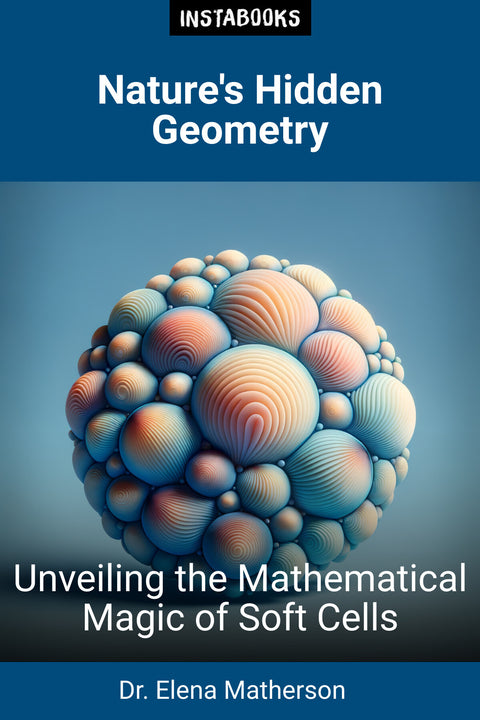
Nature's Hidden Geometry
Unveiling the Mathematical Magic of Soft Cells
Included:
✓ 200+ Page AI-Generated Book
✓ ePub eBook File — read on Kindle & Apple Books
✓ PDF Print File (Easy Printing)
✓ Word DOCX File (Easy Editing)
✓ Hi-Res Print-Ready Book Cover (No Logo Watermark)
✓ Full Commercial Use Rights — keep 100% of royalties
✓ Publish under your own Author Name
✓ Sell on Amazon KDP, IngramSpark, Lulu, Blurb & Gumroad to millions of readers worldwide
Introduction to Soft Cells
Embark on a fascinating journey through the world of "soft cells," a revolutionary class of shapes recently discovered by mathematicians. Unlike traditional polygons and polyhedra, soft cells avoid sharp corners, embracing smooth edges and rounded corners. This groundbreaking book explores how soft cells are instrumental in understanding the natural formations around us, from the cross-sections of onions to the spiraling chambers of the nautilus shell. Through captivating narrative and detailed explanations, you'll see the world through a new geometric lens.
Mathematical Principles of Soft Cells
Dive deep into the mathematical principles that make soft cells a unique phenomenon. Discover how these shapes manage to fill space more efficiently than their polyhedral counterparts, using cusp-like corners and rounded edges. The mathematics behind soft cells reveals a new approach to understanding space-filling properties, profoundly impacting both theoretical and applied sciences. In this section, you'll uncover the equations and geometric transformations that underpin this exciting discovery.
Soft Cells in Nature
Soft cells are not a mere mathematical curiosity but a pervasive natural reality. This chapter takes you on a guided tour through the natural world, showcasing how soft cells manifest in biological structures and formations. From the layers of an onion to muscle tissues, this insightful exploration connects the abstract world of geometry with the tangible wonders of biology. Soft cells are everywhere, and this book reveals their ubiquitous presence in life forms.
Biological Significance of Soft Cells
Understand why soft cells are a perfect fit for biological structures. Their ability to fill space without structural weaknesses makes them an ideal model for organisms that must resist deformation and maintain integrity. Explore how the unique properties of soft cells allow nature to bypass the energy demands of sharp corners, resulting in efficient, strong structures. This section bridges the gap between mathematical theory and biological necessity, showing how geometry shapes life as we know it.
Future Research and Applications
The discovery of soft cells is just the beginning. Delve into future research areas and applications that extend beyond geometry and biology, touching on machine learning, materials science, and beyond. With insights from leading researchers, you'll explore how soft cells could revolutionize fields like data analysis and architectural design. This section paints an exciting picture of the potential these shapes hold for future innovations.
Table of Contents
1. The Birth of Soft Cells- Discovery of a New Shape
- Understanding Soft Geometry
- Impact on Mathematics
2. Mathematical Wonders
- Space-Filling Properties
- Cusp-Like Corners Explained
- Smooth Edges in Focus
3. Nature's Geometry
- Onions and Layers
- Seashell Structures
- Natural Symmetry
4. Biology and Soft Cells
- Structural Significance
- Energy Efficiency
- Biological Integration
5. Soft Cells in Art
- Inspiration from Nature
- Designing with Shapes
- Future of Aesthetic Geometry
6. Future Research Avenues
- New Mathematical Theories
- Applications in Technology
- Cross-Disciplinary Innovations
7. Applications in Science
- Machine Learning Potentials
- Influence on Materials Science
- Architectural Impacts
8. Understanding Space
- Two-Dimensional Fitting
- Three-Dimensional Structures
- Volumetric Fillers
9. Soft Cells in Everyday Life
- Common Visuals
- Hidden Forms
- Recognizing Patterns
10. Cultural and Historical Context
- Historical Geometry
- Cultural Interpretations
- Evolution of Shape Understanding
11. Educational Insights
- Teaching Geometry
- Soft Cells in Curriculum
- Fostering Curiosity
12. Philosophical Reflections
- Shape and Existence
- Human Perception of Geometry
- The Infinite Beauty of Soft Shapes
Target Audience
This book is written for readers interested in mathematics, geometry, biology, and the intersection of these fields. It appeals to those curious about the natural world and the mathematical principles that govern it.
Key Takeaways
- Discover the innovative concept of "soft cells" and their geometric attributes.
- Understand the mathematical principles that allow these shapes to efficiently fill space in nature.
- Explore the presence of soft cells in biological structures, enhancing comprehension of natural formations.
- Gain insights into potential future applications of soft cells in technology and science.
- Learn about the intersection of geometry and biology, fostering a holistic view of the natural world.
